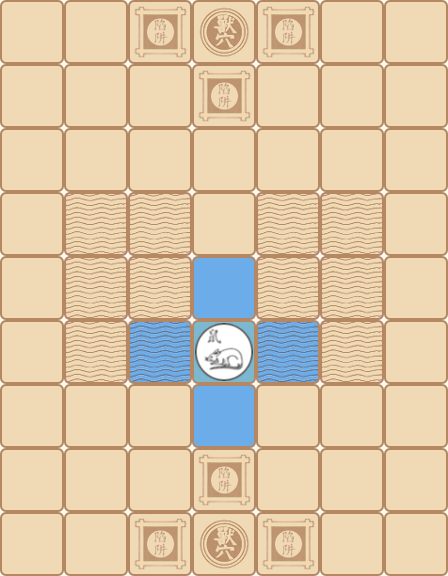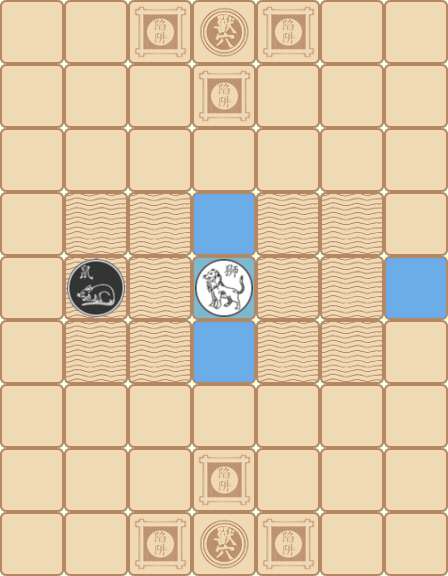About Dou Shou Qi (Jungle Chess)
Dou Shou Qi (meaning: “Game of Fighting Animals”) is a Chinese board game. In the Western world it is often called Jungle, The Jungle Game, Jungle Chess, or Animal Chess.
Dou Shou Qi is a two player abstract strategy game and it contains some elements from Chess and Stratego as well as some other chess-like Chinese games (e.g., Banqi). Its origins are not entirely clear, but it seems that it evolved rather recently (around the 1900s) in China.
The Board
Dou Shou Qi is played on a rectangular board consisting of 9×7 squares.
The columns are called files and are labelled a–g from left to right. The rows or
ranks are numbered 1–9 from bottom to top (the board is viewed from the perspective of the white player).
 There are several different kinds of squares. The dens
There are several different kinds of squares. The dens  are located in the center of the first and the last rank (d1 and d9).
Each den is surrounded by traps
are located in the center of the first and the last rank (d1 and d9).
Each den is surrounded by traps  .
.
There are also two rectangular (3×2 squares) bodies of water  sometimes called rivers.
The remaining squares are ordinary land squares.
sometimes called rivers.
The remaining squares are ordinary land squares.
The Pieces
Each player has eight different pieces representing different animals. Each animal has a certain strength, according to which they can capture other (opponent's) pieces. Only pieces with the same or a higher strength may capture an opponent's piece. The only exception to this rule regards the weakest (rat) and the strongest (elephant) pieces. Just like the spy in Stratego, the weakest piece may capture the strongest.
The strength of the pieces, from weak to strong, is: Rat (R) (sometimes called mouse)
Rat (R) (sometimes called mouse) Cat (C)
Cat (C) Wolf (W) (sometimes called fox)
Wolf (W) (sometimes called fox) Dog (D)
Dog (D) Panther (P) (sometimes called leopard)
Panther (P) (sometimes called leopard) Tiger (T)
Tiger (T) Lion (L)
Lion (L) Elephant (E)
Elephant (E)
Movement
Players alternate moves with white moving first. Each move one piece must be moved.
Each piece can move one square either horizontally or vertically. In principle a piece may not move into the water, and it is also forbidden to enter its own den (d1 for white, and d9 for black).

The rat is the only piece that can swim, and is therefore able to enter the water. It may also capture in the water (the opponent's rat), however, it may not capture the elephant from the water.

Lions and tigers are able to leap over water (either horizontally or vertically). They cannot jump over the water when a rat (own or opponent's) is on any of the intervening water squares.

Traps
When a piece is in an opponent's trap (c9, d8, e9 for white and c1, d2, e1 for black), its strength is effectively reduced to zero. Meaning that any of the opponent's pieces may capture it regardless its strength.
A piece in one of its own traps is unaffected.
The Objective
The objective of the game is to either place one of your pieces in the opponent's den or to eliminate all of the opponent's pieces.
As in Chess, threefold repetition is declared a draw as is a stalemate position.
Variations
As there are no “official” rules, the game can be played with a variety of different rules.- The elephant is not allowed to capture the rat.
- The dog is also allowed in the water.
- It is forbidden to capture from an ordinary land square into the water.
- The lions and tigers have the same strength, and may capture each other.
- The wolf is stronger than the dog.
- A lion may not jump over the water horizontally.
- Traps are universal.
- The panther is allowed to jump the water horizontally.
- And many others...
Other Sources
Zillions of Games (another implementation, using the same? rule set)
BrainKing (another implementation, using a different rule set: the elephant is not allowed to capture the rat)
LIACS - AI2013 (Jungle assignment)
Discovering and Searching Loosely Coupled Subproblems in Dou Shou Qi ([pdf] a thesis)
Playing Games: The complexity of Klondike, Mahjong, Nongrams and Animal Chess ([pdf] a thesis)
